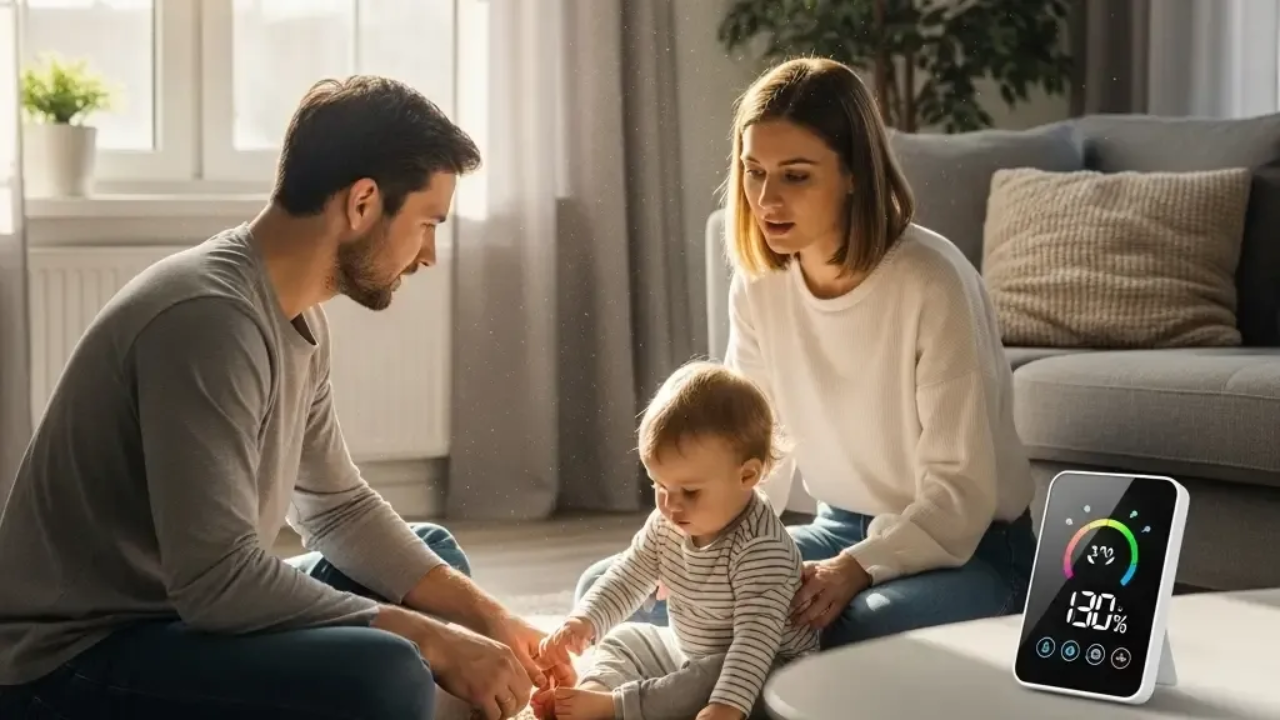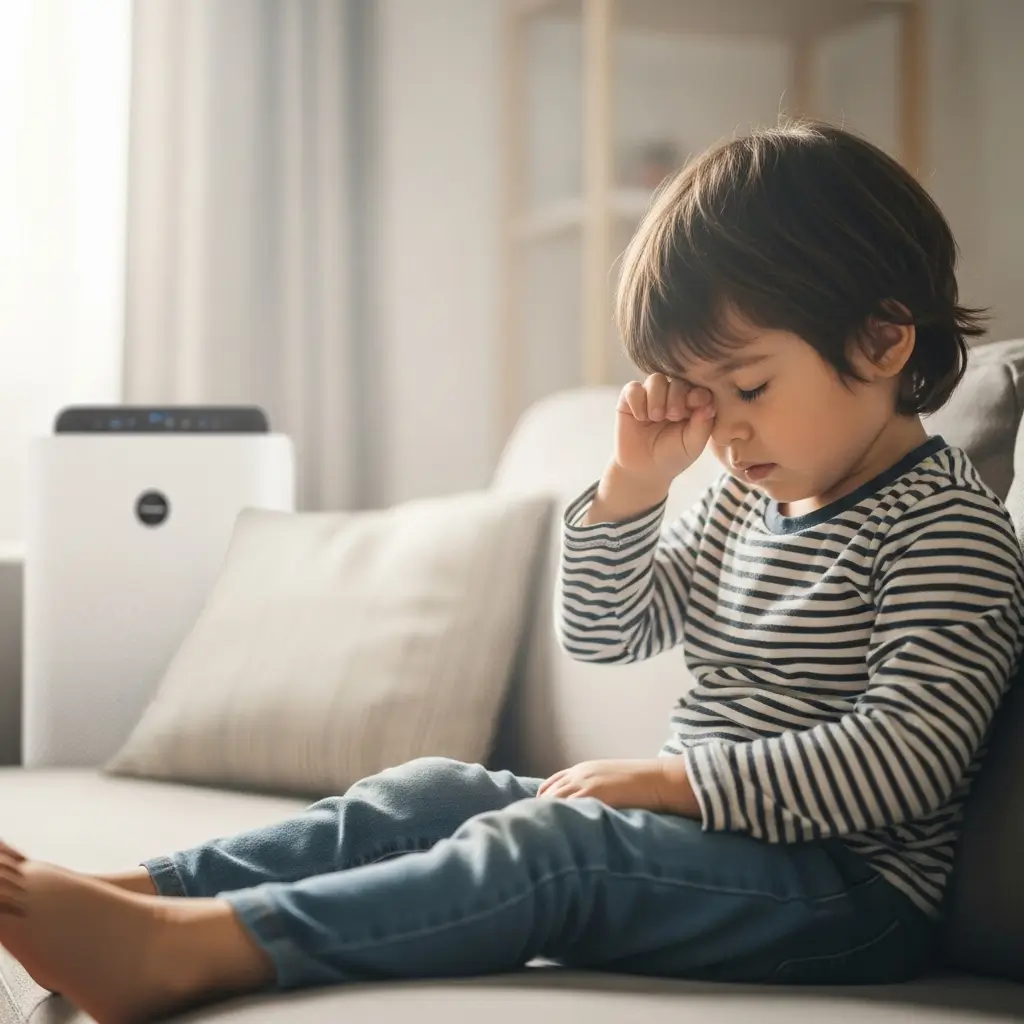
How to Test Air Quality in Your Home: A Simple Guide for Worried Parents
Nov 10, 2025Testing your home's air quality could save lives. Indoor air pollution leads to 3.2 million premature deaths worldwide each year.
Parents worry about outdoor pollution, yet the air inside our homes poses equal or greater dangers. Carbon monoxide creates a frightening scenario because this silent killer remains invisible and odorless. Radon claims 21,000 lung cancer deaths yearly in the US alone and stands as the second leading cause of lung cancer globally.
The risk to families becomes even more concerning when household mold exposure increases asthma risk by 50%. Air quality testing at home has become crucial to protect our children's health.
In this piece, we'll explore simple air quality tests you can do yourself. You'll learn what the results mean and discover practical steps to improve your indoor air. Your family deserves to breathe safe air at home.
Common Signs of Poor Air Quality in Kids

Children often show clear warning signs when exposed to poor indoor air. Recognizing these symptoms early can help you determine when to test air quality in your home.
Frequent coughing or sneezing
Persistent coughing or sneezing that seems worse indoors than outdoors is a telltale sign of indoor air quality problems. Children inhale more air relative to their body size and breathe faster than adults, making them especially vulnerable to air pollutants. Furthermore, their developing lungs are more susceptible to breathing in contaminants and hazardous air pollutants, including mold. Common indoor triggers include tobacco smoke, pet dander, dust mites, mold spores, and cockroach allergens, which are often found in carpets, bedding, and upholstery.
Unexplained headaches or fatigue
Unexplained fatigue or irritability in children, often linked to sleep disruption from congestion, can indicate poor indoor air. Studies have found that air pollution is associated with a wide range of neurological issues, including headaches. Higher levels of particulate matter have been linked to increased migraine frequency. Additionally, exposure to indoor air pollution correlates with symptoms of headaches, depression, and dizziness. Children are especially sensitive to these effects since they spend 80% to 90% of their time indoors.
Worsening asthma or allergies
Asthma affects over 9% of children in the EU, with studies showing that nearly 80% of asthma cases begin before age six. For children already diagnosed with asthma, air pollution is a known irritant and trigger for symptoms such as:
- Wheezing, coughing, and shortness of breath
- Limited speech due to wheezing
- Nocturnal awakenings due to respiratory symptoms
- Increased medication use
Indoor environmental factors that can worsen asthma include particulate matter, nitrogen oxides, secondhand smoke, and allergens from pests, pets, and molds. Notably, exposure to indoor coarse PM is associated with a 6% increase in days of cough, wheeze, or chest tightness for every 10-μg/m3 increase in concentration.
Musty smells or visible mold
A musty, sour smell in your home often indicates mold growth, which thrives in areas with water, dampness, or high humidity. Mold grows in dark spaces with warm temperatures, high humidity, and poor air flow. Inhaling mold can cause adverse health effects including coughing, wheezing, pneumonia, allergic reactions, and asthma attacks. Children exposed to mold may experience stuffy or runny nose, itchy or watery eyes, dry throat, wheezing, difficulty breathing, dry cough, skin rash, headaches, and fatigue. This is especially concerning since flood waters and standing water can become breeding grounds for mold, significantly worsening indoor air quality.
Simple Tools to Start a Home Air Quality Test
You need specific tools to test your home's air quality. Each tool targets different pollutants. A multi-tool approach gives you a full picture of your indoor air.
Indoor air quality monitors for daily tracking
Modern air quality monitors track several pollutants at once. These devices measure particulate matter (PM2.5, PM10), volatile organic compounds (VOCs), carbon dioxide (CO2), along with temperature and humidity. Quality monitors use NDIR sensors for CO2 and laser scattering technology to detect particulates. Most units show readings on a screen or smartphone app, which helps you find pollution sources quickly. You can see CO2 levels drop right after opening a window or watch dust particles decrease when your air purifier runs. This ongoing data helps you spot patterns and protect your children before they show any symptoms.
Carbon monoxide detectors for safety
Carbon monoxide (CO) can cause serious illness or death at high levels, yet you can't see or smell it. The U.S. Consumer Product Safety Commission says every home should have at least one CO alarm that meets current UL 2034 or IAS 6-96 standards. Your home needs detectors in hallways near bedrooms and on every floor. The CDC reports that CO poisoning accidentally kills over 400 Americans each year. About 60% of fire-related deaths happen in homes without working alarms. These detectors are a vital backup but don't replace regular maintenance of fuel-burning appliances.
Humidity meters to prevent mold
Mold grows when it finds moisture and food sources, especially when relative humidity stays above 75% for long periods. Hygrometers tell you when indoor humidity reaches levels that mold loves. Your indoor humidity should stay between 30% and 50%. These sensors work best in damp-prone areas like basements, bathrooms, and attics. Regular checks with these devices help you catch problem areas before mold becomes visible.
DIY radon test kits for long-term exposure
Radon ranks as the second leading cause of lung cancer and kills about 21,000 people annually in the US. Short-term radon kits measure levels for 2-90 days, while long-term kits track exposure beyond 90 days. The best spot for testing is your home's lowest livable area, 2-7 feet above the floor in a central spot. Make sure to close all exterior windows and doors 12 hours before you start testing. The EPA suggests professional help if levels hit or exceed 4 pCi/L.
Step-by-Step: How to Test Indoor Air Quality

Setting up an effective air quality test demands both strategy and patience. Let's discover the best way to obtain reliable results that accurately show what you breathe at home.
Pick the right room to test first
Your family's most frequented spaces deserve priority testing—bedrooms, living rooms, or children's play areas. The best placement for monitors is at "breathing zone height" (3-6 feet above the floor). Results can become inaccurate near direct pollutant sources like toasters or air purifiers.
Set up and fine-tune your monitor
The original setup requires placing all sensors in one location to ensure they show similar measurements. Most new monitors need time to adjust—VOC and CO2 sensors take about a week, while radon sensors require up to 30 days. Each manufacturer's guidelines help achieve the best accuracy.
Track readings over several days
Data collection should span several hours or days to capture variations. Extended monitoring reveals important patterns such as VOC increases that happen during cooking or cleaning.
Compare results to safe levels
Safe level guidelines serve as crucial reference points. To name just one example, particulate matter readings between 33-55 µg/m³ create risks for people with respiratory conditions, while levels above 55 µg/m³ affect everyone's health.
Use multiple tools for different pollutants
Different contaminants need specific detection methods, so you should employ various testing tools. Professional testing typically combines specialized sensors placed throughout your home.
What to Do If the Air Quality Is Bad
You need to act fast when you find poor air quality in your home. The good news is that you have several ways to make what your family breathes a lot better.
Ventilate and use air purifiers
Fresh outdoor air helps dilute indoor pollutants through proper ventilation. You should open windows when outdoor air is clean and run bathroom exhaust fans for 30-45 minutes after showers. Your HVAC fan works better at trapping virus particles when set to "on" instead of "auto". Air purifiers with HEPA filters work great in areas with ongoing problems. These devices can remove most airborne allergens like dust, pollen, mold spores, pet dander, and even smoke.
Fix leaks and reduce humidity
Your indoor humidity should stay between 30-50% to stop mold from growing. Damp areas like basements need dehumidifiers. Leaky pipes, roofs, and foundations add too much moisture, so fix them right away. You should check your home's windows and pipes regularly for condensation.
Switch to low-VOC cleaning products
Regular cleaning products can hurt your indoor air quality because they release volatile organic compounds (VOCs). Look for products with EPA's Safer Product Standards certification. Stay away from cleaners that contain pine or citrus oils, especially when ozone levels are high. Make sure you have good airflow while cleaning.
Call professionals for mold or radon issues
Air quality tests might show serious problems like mold or radon that need expert help. The EPA says you need professional mitigation when radon levels hit or exceed 4 pCi/L. Big mold problems also need special equipment and expertise to fix them properly.
Conclusion
Testing your home's air quality is vital to protect your family's health. This piece shows how common indoor pollutants can harm children's developing bodies. Parents should watch for warning signs like constant coughing, unexplained headaches, and worsening asthma symptoms.
The right tools help you spot dangers before they harm your loved ones. Air quality monitors, carbon monoxide detectors, humidity meters, and radon test kits give you data to make smart choices about your home environment.
Knowledge alone won't protect your family. When you find air quality problems, act fast. Get fresh air by opening windows, fix any moisture issues, use low-VOC products, and call experts if you spot mold or radon.
Your children spend most of their time inside your home. The air they breathe affects their health and how they grow. Indoor air pollution might seem scary at first, but these testing methods and fixes make it easy to protect your family.
Note that even small changes can lead to major improvements. Knowing your home's air is safe makes all this work worth it. Your family deserves to breathe the cleanest air possible.
Don't miss a beat!
New moves, motivation, and classes delivered to your inbox.
We hate SPAM. We will never sell your information, for any reason.

